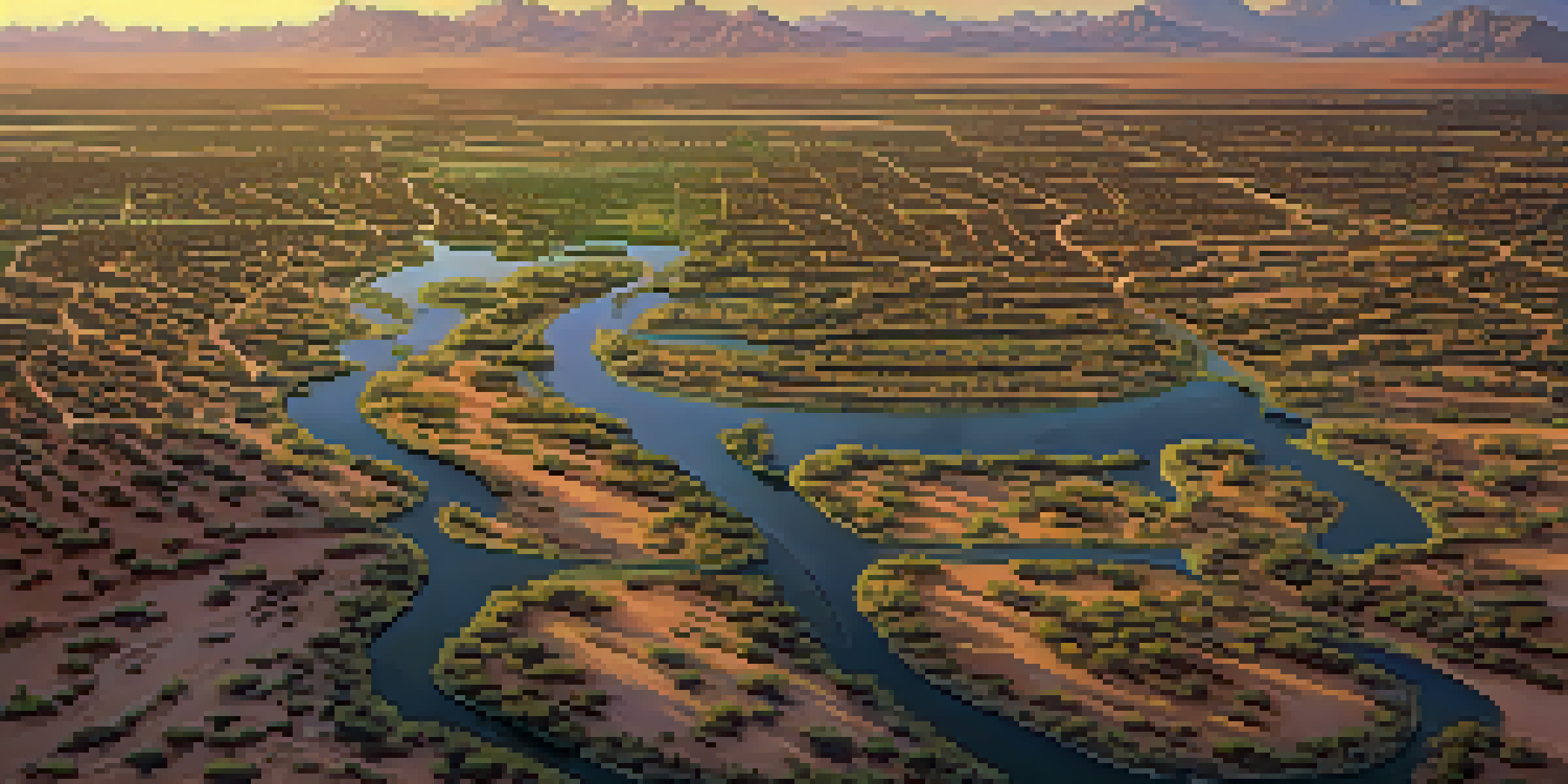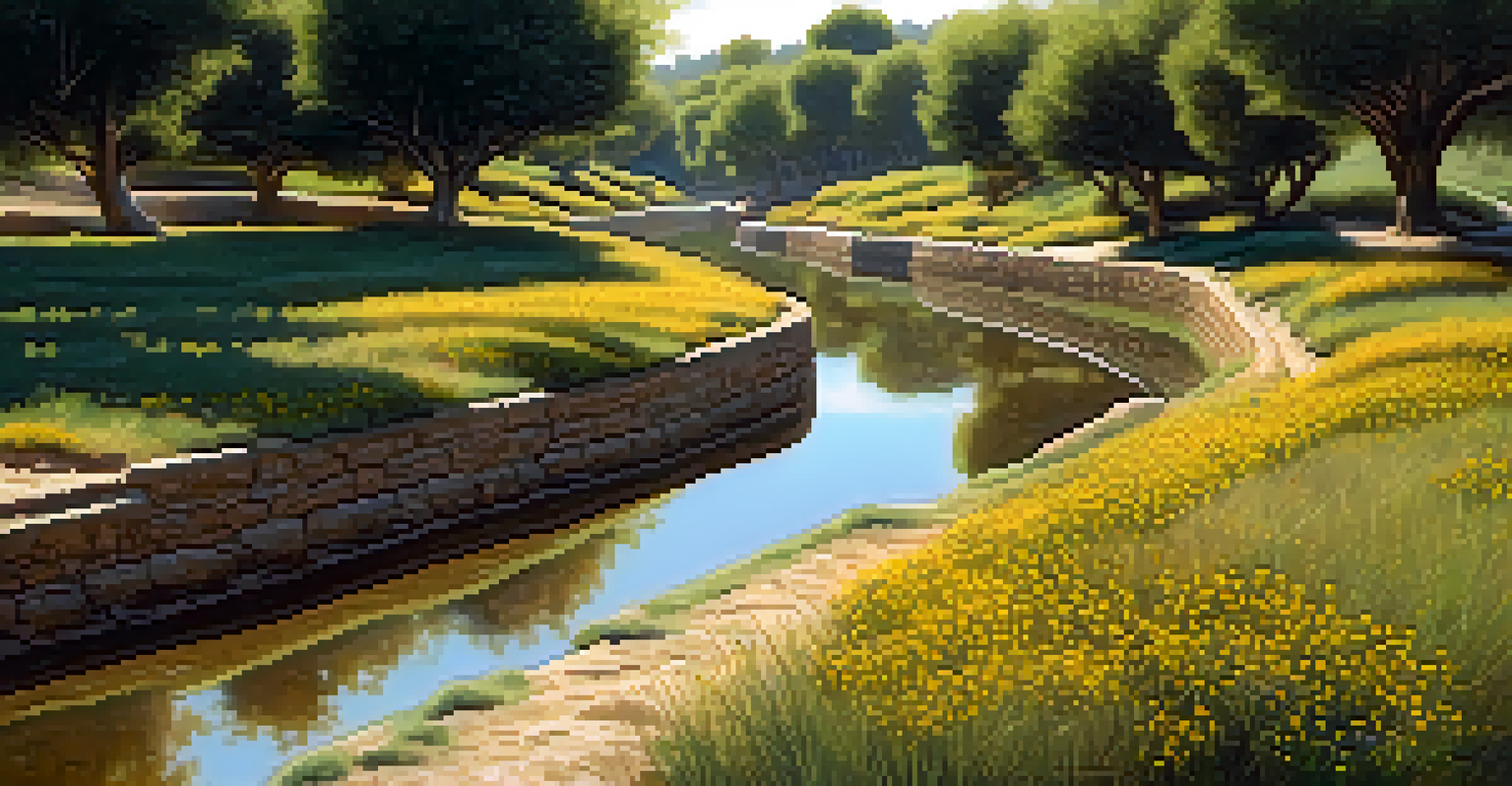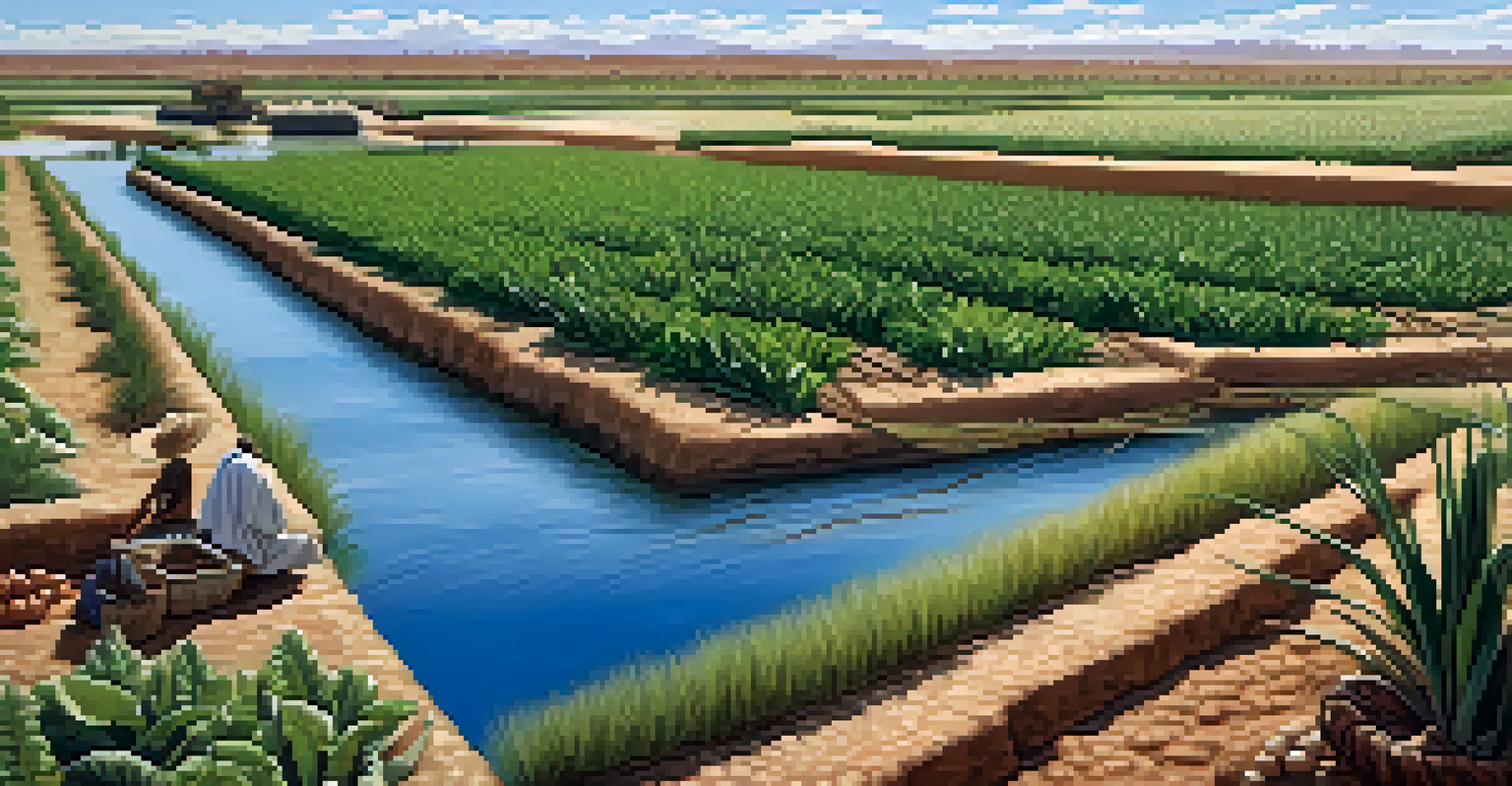The Ancient Canals of Arizona: A Historical Overview

Introduction to Arizona's Ancient Canals
Arizona is often associated with its stunning desert landscapes, but beneath the surface lies a rich history of ancient engineering. The canals created by indigenous peoples were not just water channels; they were lifelines that supported entire communities. Understanding these canals offers a glimpse into the ingenuity and adaptability of ancient cultures in arid regions.
Water is the driving force of all nature.
These canals, primarily developed by the Hohokam civilization, date back to around 300 AD. They showcase how people harnessed the power of water to cultivate crops in a challenging environment. The remains of these ancient waterways can still be seen today, serving as a testament to the advanced agricultural techniques of the time.
As we delve deeper into their history, we'll explore how these canals transformed the landscape and contributed to the growth of societies in Arizona. From their construction to their eventual decline, the story of these canals is a captivating chapter in the region's history.
The Hohokam Civilization and Their Canal Systems
The Hohokam civilization, which flourished from about 300 to 1500 AD, is credited with the creation of an extensive network of canals in central Arizona. These canals were marvels of engineering, some stretching over miles, designed to divert water from rivers to agricultural fields. The Hohokam's ability to manipulate water flow showcased their understanding of hydrology and agriculture.

Archaeologists believe the Hohokam constructed over 1,000 miles of canals, allowing them to cultivate crops such as cotton, corn, and beans. This agricultural bounty supported a thriving population and facilitated trade with neighboring tribes. The canals not only provided irrigation but also connected communities, fostering social and economic interactions.
Hohokam Canals: Ingenious Engineering
The Hohokam civilization developed an extensive network of canals that showcased advanced engineering skills and effective water management in Arizona's arid landscape.
However, the decline of the Hohokam civilization in the 15th century raises questions about the sustainability of their canal systems. Factors such as climate change, resource depletion, and social upheaval likely contributed to their downfall, leaving behind a fascinating yet cautionary tale about the relationship between civilization and its environment.
Engineering Marvels: The Construction of the Canals
The construction of these ancient canals was no small feat; it required remarkable engineering skills and an understanding of water dynamics. Hohokam people used simple tools to dig trenches, create embankments, and divert water from rivers like the Salt and Gila. The precision involved in aligning these canals for optimal irrigation demonstrates their advanced knowledge of the local terrain.
Civilizations are not remembered by their business people, their politicians, or their military leaders. They are remembered by the arts they leave behind, the cultural legacies they create, and the challenges they face in adapting to their environment.
The canals were designed to maximize water efficiency, with some featuring a slight slope to ensure a constant flow. This careful planning allowed for the irrigation of vast areas, turning arid land into fertile fields. The ingenuity of these ancient engineers stands as a testament to their adaptability in a harsh environment.
Moreover, the ability to manage water resources effectively played a crucial role in the sustainability of their agriculture. This ancient knowledge of canal construction and water management can still inspire modern-day practices in water-scarce regions, highlighting the timeless relevance of their innovations.
The Cultural Significance of Canals to Indigenous Peoples
Beyond their practical use, the canals held significant cultural importance for the Hohokam and other indigenous peoples. They were central to community life, supporting not just agriculture but also social gatherings and rituals. Water was revered, often seen as a sacred source of life that connected people to the land and to each other.
The canals facilitated the development of complex societies and social structures. As communities grew around these waterways, they became hubs of trade and interaction, fostering cultural exchange among different tribes. The canals were not just physical structures; they were woven into the very fabric of life for the people who depended on them.
Cultural Impact of Waterways
The canals were vital not just for irrigation but also for fostering community interactions, trade, and cultural exchange among indigenous peoples.
Today, the legacy of these ancient canals is celebrated by descendants of the Hohokam. Efforts to preserve and honor this history reflect a deep respect for the ingenuity and resilience of their ancestors, emphasizing the importance of understanding the past in shaping future identities.
The Decline of the Canal Systems
The decline of the Hohokam civilization and their canal systems raises intriguing questions about environmental sustainability and social resilience. Several factors likely contributed to this decline, including prolonged droughts, overuse of water resources, and possible sociopolitical changes. As conditions worsened, the ability to maintain these intricate canal systems diminished.
Archaeological evidence suggests that by the 15th century, many canals fell into disrepair, leading to decreased agricultural productivity. This decline likely triggered shifts in population as communities sought more hospitable environments. The abandonment of these canals marked a significant turning point in the region's history, affecting both the landscape and the people who once thrived there.
Understanding this decline can offer valuable lessons for contemporary society. As we face challenges related to water scarcity and climate change, reflecting on the Hohokam's experiences can inform modern practices in resource management and community resilience.
Modern Discoveries: Archaeological Findings and Research
In recent years, archaeological research has uncovered fascinating insights into Arizona's ancient canals. Excavations have revealed the extent of the canal systems, as well as tools and artifacts associated with their construction and use. Modern technology, such as aerial photography and ground-penetrating radar, has allowed researchers to identify previously unknown canal routes.
These discoveries are not just about uncovering the past; they also contribute to our understanding of how ancient peoples adapted to their environment. As scholars continue to study these sites, they are piecing together a more comprehensive picture of the Hohokam way of life, including their agricultural practices and social organization.
Lessons on Sustainability Today
The decline of the Hohokam canals serves as a cautionary tale about environmental sustainability, offering valuable insights for modern resource management and community resilience.
Moreover, these findings highlight the importance of preserving archaeological sites for future generations. As modern development encroaches on these historical landscapes, ongoing research and conservation efforts are essential to ensure that the legacy of Arizona's ancient canals is not lost.
The Legacy of Ancient Canals in Arizona Today
The legacy of Arizona's ancient canals continues to resonate in contemporary society. Many modern irrigation systems draw inspiration from the innovative techniques developed by the Hohokam. Understanding these ancient practices can help inform sustainable water management strategies in arid regions today, where water scarcity is an ongoing challenge.
Additionally, the preservation of canal sites has become a focus for cultural heritage initiatives. Local communities and organizations are working to raise awareness about the significance of these historical waterways, fostering a deeper connection to the land. By celebrating this heritage, they aim to educate future generations about the importance of water conservation and sustainable practices.

In conclusion, the story of Arizona's ancient canals is not just a tale of the past; it is a reminder of the intricate relationship between people and their environment. As we navigate modern challenges, the lessons learned from these ancient engineers can guide us toward a more sustainable future.